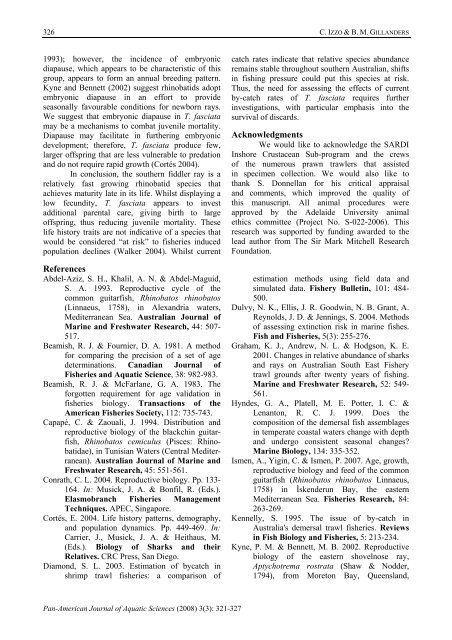Initial assessment of age, growth and reproductive ... - PanamJAS
Initial assessment of age, growth and reproductive ... - PanamJAS
Initial assessment of age, growth and reproductive ... - PanamJAS
Create successful ePaper yourself
Turn your PDF publications into a flip-book with our unique Google optimized e-Paper software.
326C. IZZO & B. M. GILLANDERS1993); however, the incidence <strong>of</strong> embryonicdiapause, which appears to be characteristic <strong>of</strong> thisgroup, appears to form an annual breeding pattern.Kyne <strong>and</strong> Bennett (2002) suggest rhinobatids adoptembryonic diapause in an effort to provideseasonally favourable conditions for newborn rays.We suggest that embryonic diapause in T. fasciatamay be a mechanisms to combat juvenile mortality.Diapause may facilitate in furthering embryonicdevelopment; therefore, T. fasciata produce few,larger <strong>of</strong>fspring that are less vulnerable to predation<strong>and</strong> do not require rapid <strong>growth</strong> (Cortés 2004).In conclusion, the southern fiddler ray is arelatively fast growing rhinobatid species thatachieves maturity late in its life. Whilst displaying alow fecundity, T. fasciata appears to investadditional parental care, giving birth to large<strong>of</strong>fspring, thus reducing juvenile mortality. Theselife history traits are not indicative <strong>of</strong> a species thatwould be considered “at risk” to fisheries inducedpopulation declines (Walker 2004). Whilst currentReferencesAbdel-Aziz, S. H., Khalil, A. N. & Abdel-Maguid,S. A. 1993. Reproductive cycle <strong>of</strong> thecommon guitarfish, Rhinobatos rhinobatos(Linnaeus, 1758), in Alex<strong>and</strong>ria waters,Mediterranean Sea. Australian Journal <strong>of</strong>Marine <strong>and</strong> Freshwater Research, 44: 507-517.Beamish, R. J. & Fournier, D. A. 1981. A methodfor comparing the precision <strong>of</strong> a set <strong>of</strong> <strong>age</strong>determinations. Canadian Journal <strong>of</strong>Fisheries <strong>and</strong> Aquatic Science, 38: 982-983.Beamish, R. J. & McFarlane, G. A. 1983. Theforgotten requirement for <strong>age</strong> validation infisheries biology. Transactions <strong>of</strong> theAmerican Fisheries Society, 112: 735-743.Capapé, C. & Zaouali, J. 1994. Distribution <strong>and</strong><strong>reproductive</strong> biology <strong>of</strong> the blackchin guitarfish,Rhinobatos cemiculus (Pisces: Rhinobatidae),in Tunisian Waters (Central Mediterranean).Australian Journal <strong>of</strong> Marine <strong>and</strong>Freshwater Research, 45: 551-561.Conrath, C. L. 2004. Reproductive biology. Pp. 133-164. In: Musick, J. A. & Bonfil, R. (Eds.).Elasmobranch Fisheries Man<strong>age</strong>mentTechniques. APEC, Singapore.Cortés, E. 2004. Life history patterns, demography,<strong>and</strong> population dynamics. Pp. 449-469. In:Carrier, J., Musick, J. A. & Heithaus, M.(Eds.). Biology <strong>of</strong> Sharks <strong>and</strong> theirRelatives. CRC Press, San Diego.Diamond, S. L. 2003. Estimation <strong>of</strong> bycatch inshrimp trawl fisheries: a comparison <strong>of</strong>catch rates indicate that relative species abundanceremains stable throughout southern Australian, shiftsin fishing pressure could put this species at risk.Thus, the need for assessing the effects <strong>of</strong> currentby-catch rates <strong>of</strong> T. fasciata requires furtherinvestigations, with particular emphasis into thesurvival <strong>of</strong> discards.AcknowledgmentsWe would like to acknowledge the SARDIInshore Crustacean Sub-program <strong>and</strong> the crews<strong>of</strong> the numerous prawn trawlers that assistedin specimen collection. We would also like tothank S. Donnellan for his critical appraisal<strong>and</strong> comments, which improved the quality <strong>of</strong>this manuscript. All animal procedures wereapproved by the Adelaide University animalethics committee (Project No. S-022-2006). Thisresearch was supported by funding awarded to thelead author from The Sir Mark Mitchell ResearchFoundation.estimation methods using field data <strong>and</strong>simulated data. Fishery Bulletin, 101: 484-500.Dulvy, N. K., Ellis, J. R. Goodwin, N. B. Grant, A.Reynolds, J. D. & Jennings, S. 2004. Methods<strong>of</strong> assessing extinction risk in marine fishes.Fish <strong>and</strong> Fisheries, 5(3): 255-276.Graham, K. J., Andrew, N. L. & Hodgson, K. E.2001. Changes in relative abundance <strong>of</strong> sharks<strong>and</strong> rays on Australian South East Fisherytrawl grounds after twenty years <strong>of</strong> fishing.Marine <strong>and</strong> Freshwater Research, 52: 549-561.Hyndes, G. A., Platell, M. E. Potter, I. C. &Lenanton, R. C. J. 1999. Does thecomposition <strong>of</strong> the demersal fish assembl<strong>age</strong>sin temperate coastal waters change with depth<strong>and</strong> undergo consistent seasonal changes?Marine Biology, 134: 335-352.Ismen, A., Yigin, C. & Ismen, P. 2007. Age, <strong>growth</strong>,<strong>reproductive</strong> biology <strong>and</strong> feed <strong>of</strong> the commonguitarfish (Rhinobatos rhinobatos Linnaeus,1758) in İskenderun Bay, the easternMediterranean Sea. Fisheries Research, 84:263-269.Kennelly, S. 1995. The issue <strong>of</strong> by-catch inAustralia's demersal trawl fisheries. Reviewsin Fish Biology <strong>and</strong> Fisheries, 5: 213-234.Kyne, P. M. & Bennett, M. B. 2002. Reproductivebiology <strong>of</strong> the eastern shovelnose ray,Aptychotrema rostrata (Shaw & Nodder,1794), from Moreton Bay, Queensl<strong>and</strong>,Pan-American Journal <strong>of</strong> Aquatic Sciences (2008) 3(3): 321-327
















